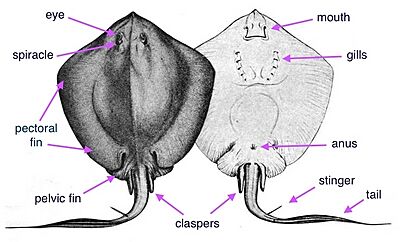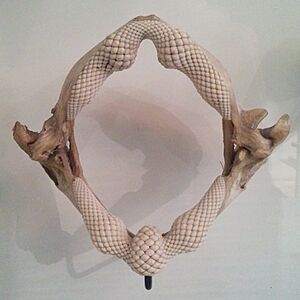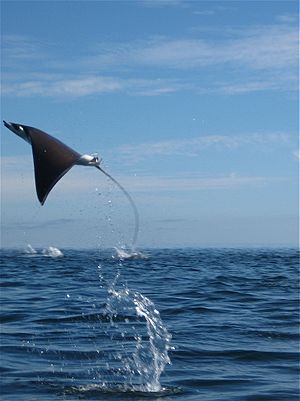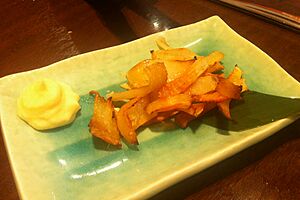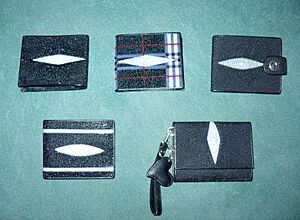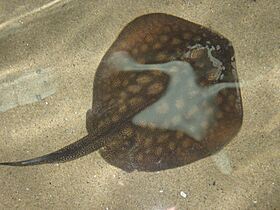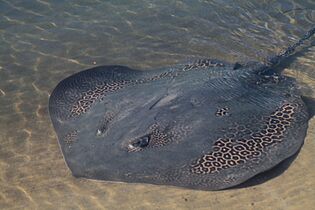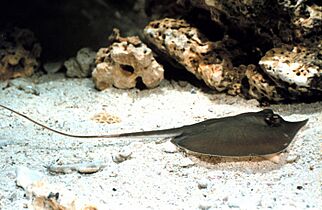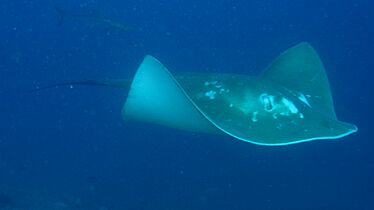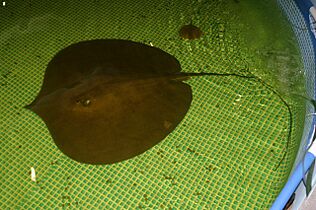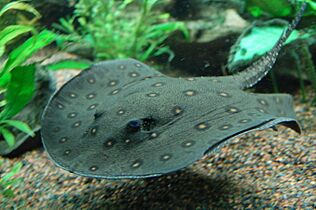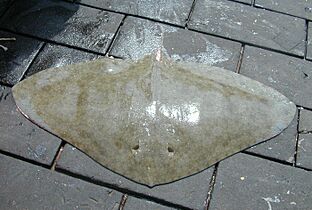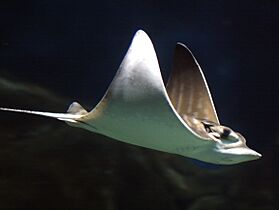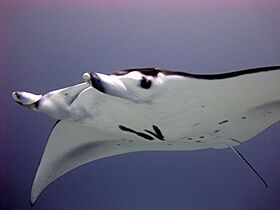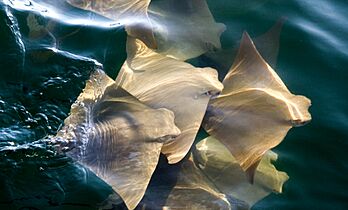Stingray facts for kids
Quick facts for kids Stingrays |
|
|---|---|
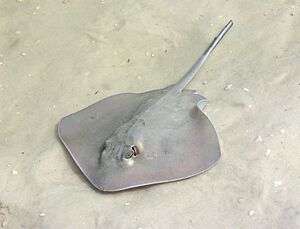 |
|
| Southern stingray (Hypanus americanus) | |
| Scientific classification |
|
| Kingdom: | Animalia |
| Phylum: | Chordata |
| Class: | Chondrichthyes |
| Order: | Myliobatiformes |
| Suborder: | Myliobatoidei Compagno, 1973 |
| Families | |
|
|
Stingrays are a group of amazing sea creatures. They are a type of ray, which means they are related to sharks. Like sharks, stingrays have skeletons made of tough, flexible material called cartilage, not bone. There are about 220 different kinds of stingrays. They are found in warm, coastal waters around the world. Some stingrays live in the deep ocean, and a few even live in fresh water rivers! Sadly, many stingray species are becoming endangered because of too much fishing.
Contents
Stingray History: How They Evolved
Stingrays have been around for a very long time. They first appeared during the Late Jurassic period. Over millions of years, they changed and developed into the different types we see today. The earliest stingrays likely lived on the ocean floor. Later, some of their relatives, like the eagle rays, started swimming in the open ocean.
Ancient Stingray Fossils

Scientists have found fossilized stingray teeth in rocks all over the world. These teeth can be as old as the Early Cretaceous period. Stingray teeth are like tiny, modified scales. They are regularly shed and replaced, just like shark teeth.
Finding a complete stingray fossil is very rare. This is because their bodies are mostly cartilage, which doesn't fossilize as easily as bone. However, some amazing fossils have been found. For example, Heliobatis and Asterotrygon are ancient freshwater stingrays found in the Green River Formation. Another unusual fossil is Lessiniabatis, which had a very short tail without a sting.
Stingray Body Parts
Stingrays have flat bodies that help them hide in the sand. Their eyes are on top of their bodies, but their mouths are underneath. This means they can't see their prey when they catch it. Instead, they use their sense of smell and special sensors to find food.
Mouth and Teeth
A stingray's mouth is on its underside. Their jaws can move a lot, helping them grab food. Their teeth are very strong and flat, perfect for crushing the shells of crabs and clams. Male stingrays sometimes have pointed teeth during mating season. These teeth help them hold onto the female.
Spiracles: How Stingrays Breathe
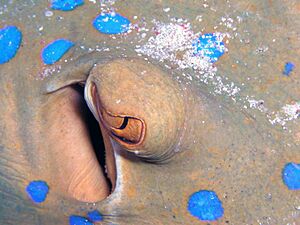
Stingrays have small openings called spiracles just behind their eyes. These help them breathe. Most of the time, stingrays take in water through their mouths. The water then goes over their gills to get oxygen.
But when a stingray hides in the sand to hunt, it can't use its mouth. So, it switches to using its spiracles. The spiracles pull clean water directly into their gills. This way, they can breathe even when buried in the sand. Spiracles are not as efficient as breathing through the mouth, but they work well enough for waiting for prey.
Stingray Behavior
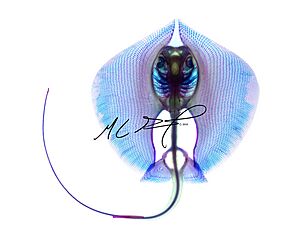
Reproduction and Life Cycle
Stingrays give birth to live young. They usually have litters of five to thirteen babies. The mother keeps the embryos inside her body. The babies first get food from a yolk sac. After that, the mother provides a special "uterine milk."
Once born, the baby stingrays usually swim away from their mother. They are born knowing how to protect and feed themselves. In a few species, like the giant freshwater stingray, the mother lets her young swim with her until they are bigger.
How Stingrays Move

Stingrays use their large, flat side fins, called pectoral fins, to move around. This is different from sharks and most other fish, which use their tail fins to swim. Stingrays move their fins in two main ways:
- Undulation: They make wave-like motions with their fins. This is used by stingrays with shorter, thicker fins for slower movements near the ocean floor.
- Oscillation: They flap their fins up and down like wings. Stingrays with longer, thinner fins use this for faster swimming in the open ocean.
Feeding and Diet
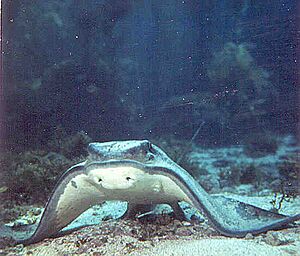
Stingrays have many ways to find food. Some have strong jaws to crush hard shells. Others use special mouth parts to guide tiny plankton into their mouths.
Stingrays that live on the sea floor are ambush hunters. They wait for prey to come close. Then, they use a trick called "tenting." They press their fins against the sand and lift their heads. This creates a suction force that pulls the prey right under their bodies.
Stingrays often have colors and patterns on their backs that help them blend in with the sandy bottom. Some can even change their color over a few days to match new places. Since their mouths are on their underside, they catch prey and then crush it with their powerful jaws. Like sharks, stingrays have special electrical sensors around their mouths. These sensors help them find the natural electrical charges given off by potential prey. Most stingrays eat mollusks (like clams and oysters), crustaceans (like crabs), and sometimes small fish. Freshwater stingrays in the Amazon even eat insects. Large open-ocean rays, like the manta, eat huge amounts of plankton by swimming with their mouths open.
Stingray Stings
Stingrays are usually calm animals. They only attack humans if they feel threatened, often when someone accidentally steps on them. A stingray can have one, two, or even three sharp blades on its tail.
If you get stung, it can be very painful. The sting causes a cut, swelling, and muscle cramps from the venom. Later, the wound might get infected. While very painful, a stingray injury is rarely life-threatening. However, the stinger can break off in the wound, and surgery might be needed to remove it.
Very few stingray stings are fatal. A famous example was the death of Steve Irwin in 2006. His stinger went into his chest and pierced his heart, causing severe injury. This was a very rare and tragic event.
Stingray Venom
Scientists are still studying stingray venom. The venom is released from special cells in the skin layer covering the spine. When the stingray stings, the venom mixes with mucus and enters the victim. Unlike many other venomous animals that store venom in a gland, stingrays store it inside their tissue cells.
The venom contains different toxins. These toxins can cause increased blood flow and cell damage in humans. Interestingly, stingrays don't need much energy to make and store their venom.
The stinging cells of marine (ocean) stingrays are only in the grooves on the sides of the stinger. However, freshwater stingrays have stinging cells that spread out more, covering a larger area of the blade. This means that freshwater stingray venom is often stronger than marine stingray venom.
Stingrays and Humans
As Food
Stingrays are eaten in many coastal areas around the world. People catch them with fishing lines or spears. In places like Malaysia and Singapore, stingray meat is often grilled and served with spicy sauce. In India, it's sometimes used in spicy curries. The best parts to eat are usually the "wings" (pectoral fins), the area around the eyes, and the liver. The rest of the ray is often too tough to eat.
Ecotourism
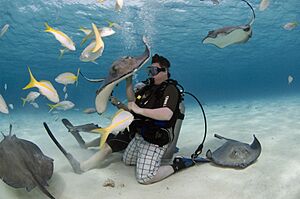
Stingrays are usually gentle and curious. Their first reaction is to swim away if disturbed. However, some larger species can be more aggressive. It's important to be careful around them, as their sting can cause serious injury. Many places offer tours where you can swim with stingrays, like Stingray City in the Cayman Islands.
Other Uses
The tough, rough skin of stingrays is used for different things. In Japan, it's used as an underlayer for the handle wraps on Japanese swords. This rough texture helps the wrap stay in place.
In museums, you can sometimes see arrowheads and spearheads made from stingray stingers. These were used by people in places like Micronesia. Before World War II, whips made from the tails of large stingrays were used in the Horn of Africa. These whips could cause painful cuts.
Some stingray species are also popular in public aquariums and even in home aquariums.
Gallery
-
Unlike other rays, sixgill stingrays (Hexatrygon bickelli) have six rather than five pairs of gill slits.
-
Deepwater stingrays (Plesiobatis daviesi) are found on the upper continental slope throughout the Indo-Pacific.
-
Spotted stingarees (Urolophus gigas) are found along the Western Australian coast.
-
Round stingrays (Urobatis halleri) frequently sting beachgoers along the Western American coast.
-
Leopard whiprays (Himantura leoparda) are vulnerable from overfishing.
-
Atlantic stingrays (Hypanus sabinus) are found in marine, brackish, and freshwater environments along the Southeastern United States coast.
-
The pelagic stingray (Pteroplatytrygon violacea) is one of the few stingrays that primarily inhabit the open ocean.
-
Bluespotted ribbontail rays (Taeniura lymma) are near threatened.
-
Giant freshwater stingrays (Urogymnus polylepis) are the largest freshwater fish.
-
Ocellate river stingrays (Potamotrygon motoro) are found in South American rivers.
-
Spiny butterfly rays (Gymnura altavela) are endangered from overfishing. Found along the lower East Coast of the United States and the South American coast.
-
Giant oceanic manta rays (Mobula birostris) are the largest of the stingrays.
See also
 In Spanish: Myliobatoidei para niños
In Spanish: Myliobatoidei para niños



